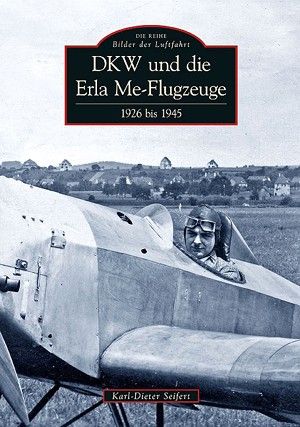
Karl-Dieter Seifert, Sutton Verlag GmbH, Erfurt, Germany, 2011, ISBN 978-3-86680-852-2. Illustrated, softcover, published in German.
Cover image © by Sutton Verlag GmbH, 2011.
Karl-Dieter Seifert's DKW und die Erla Me-Flugzeuge 1926 bis 1945 [DKW And Erla Me Aircraft 1926 To 1945] is a true gem. A relatively thin book (at 128 pages), it sheds light on an important but thus far somewhat insufficiently covered and therefore largely unknown facet of German aviation history - the inception of the Erla aircraft factory, and that company's difficult path towards becoming one of Germany's most important aircraft manufacturers of the Second World War. It is notable, for example, that Erla built roughly one third of all Messerschmitt Bf 109s produced. Erla's average daily output of Bf 109s in 1944 was 12 aircraft, in spite of massive supply problems and constant bombing of its manufacturing plants.
Erla was established in 1933 as a small joint venture between sports and sailplane designer Franz Xaver Mehr and Jørgen Skafte Rasmussen's DKW car and motor factory. Erla was originally intended to simply produce the small, single-seat Erla Me 5 sports aircraft, designed by Mehr (hence the "Me" designation). With the rise of the Third Reich and the increasing efforts to re-arm Germany in anticipation of a new war, Erla began to be involved in the license production of military aircraft. By the end of the war, Erla was scheduled to produce Focke-Wulf Ta 152 H fighters. Production activities were by then widely dispersed and/or undertaken by disguised manufacturing facilities operating under code names.
By necessity, the focal point of Seifert's DKW und die Erla Me-Flugzeuge 1926 bis 1945 often lies on Mehr's personal biography, as he remained one of the most noteworthy individuals involved with Erla throughout the company's existence. Mehr found it difficult to relinquish his aspirations to improve upon his early sports aeroplane designs in favour of the demands of the German air ministry (RLM). He even financed some of the work on his later designs from his own salary. Still, the realities of Germany's political course meant that these designs remained prototypes and never entered mass production. Unfortunately, much of Mehr's life is still shrouded in mystery.
DKW und die Erla Me-Flugzeuge 1926 bis 1945 mainly investigates the uneasy balance between Mehr's visions and Erla's inexorable conversion from a small aircraft company to a hugely important military aircraft manufacturer, in the timeframe from the company's inception to the outbreak of the war. This includes the complex and often questionable personal and financial machinations employed to force Erla to align with the RLM's intentions. Erla's further destiny during the war and immediately after the cessation of hostilities is only fleetingly covered on a few pages.
Nonetheless, the book is an extremely absorbing read, and the text further benefits from the inclusion of some 70 mainly unpublished photos and facsimile documents. For anyone truly interested in German sports and paramilitary aviation of the 1920s and 1930s, even these photos alone are reason enough to purchase this little book - as evidenced, for example, by its very cover image.